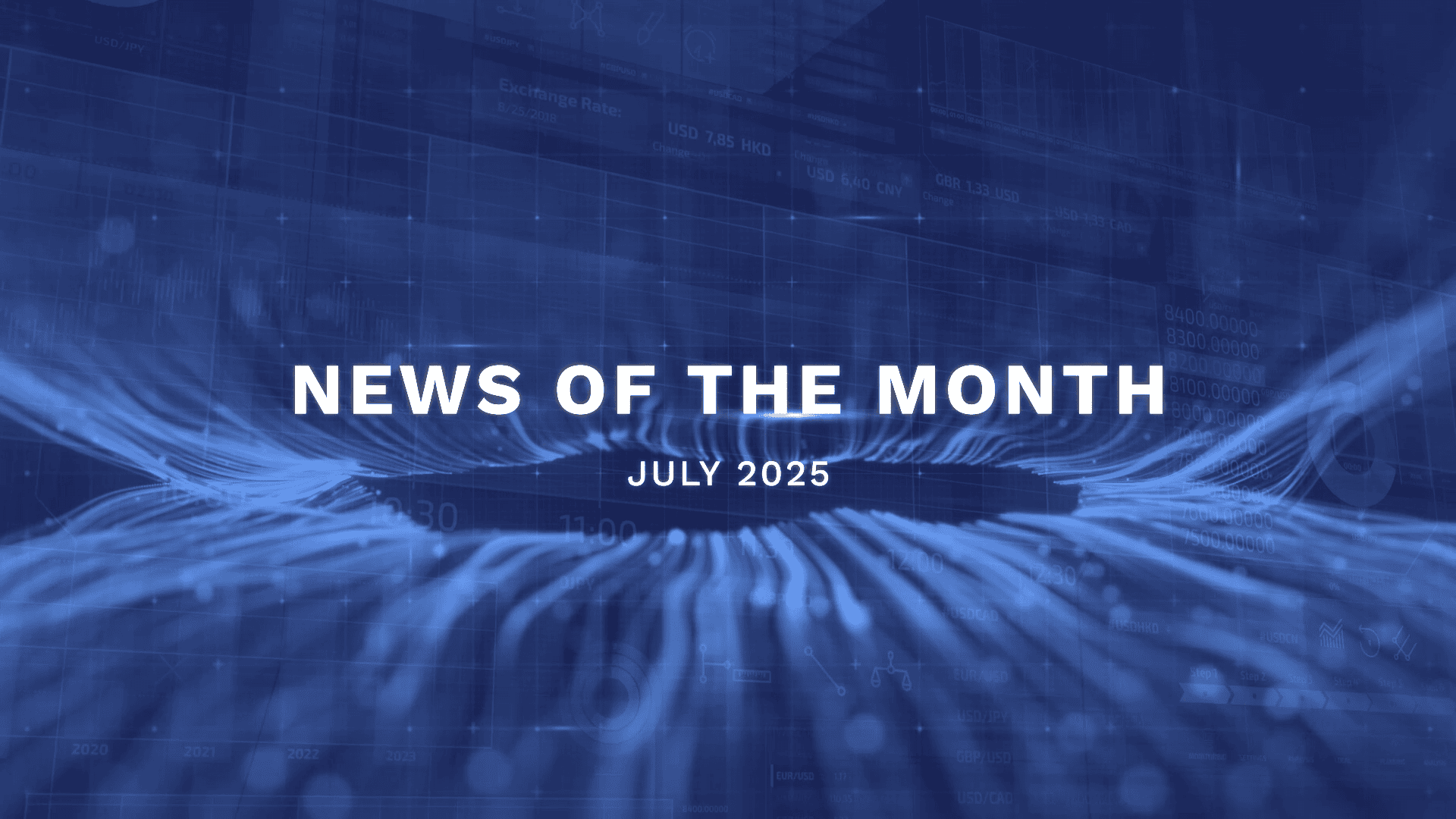As every month, you can read our investment report, in which we offer you a macroeconomic analysis of the market, a presentation of the performance of our funds and their results.

You can also watch our video update on the Digital Funds range.
The stock market rally that began almost 3 years ago continued during the first half of the year (MSCI Europe NR +8.5% in EUR), despite the particularly turbulent political and geopolitical situation. Strong trends have emerged during the half-year, which has been particularly favourable to the « Momentum » style, which topped the European styles league table with a +15.3% year-to-date performance (excluding dividends).
Two major themes guided the markets during the semester: a fundamental normalization and domesticity. The fundamental normalization is a fairly traditional phenomenon in the final phase of a stock market rally, which consists in bringing the various market segments closer to their standard valuation levels. This explains why the Value style performed well over the half-year. At the start of the year, all Value sectors, i.e. those with low valuations, were trading at a discount to their historical valuation standards. This is no longer the case. Conversely, at the start of the year, the « expensive » sectors, particularly the “Visibility” sectors (food & beverage, consumer goods, healthcare), carried a valuation premium, which their recent significant underperformance has gradually helped to normalize.
As for the interest in domestic stocks, this will come as no surprise in a political context dominated by the new Trump administration’s threats on tariffs. All the more so with the euro rising sharply against the dollar, weighing on exporting companies in relative terms.
The second half of the year could be somewhat different, however. The Fed could well surprise investors by resuming its rate cuts, allowing the Trump administration to loosen its grip on tariffs.
Digital Stars Europe Acc posted a +0.2% return in June, outperforming the MSCI Europe NR by +1.5%. Since the start of the year, the fund has outperformed its index by +5.5%.
Small and mid caps, which are well represented in the fund, performed very well in June in relative terms. The fund’s sector allocation was positively aligned with the market, particularly with an overweight in industry and underweight in healthcare and consumer staples. A number of stocks stood out, like Clariane in healthcare, Morgan Sindall in construction or Kongsberg Gruppen in defence. However, the defence sector suffered a number of setbacks with stocks like MilDef or RENK Group. The portfolio reviews carried out in June were diversified, mainly increasing our positions in the finance sector, as well as in materials and industry. Among the exits were mainly companies from the healthcare and real estate sectors. Digital Stars Europe is still significantly overweight finance and industry, and underweight healthcare and consumer staples. The UK remains the fund’s top country weight with 20.9%, ahead of Germany at 16.2% and Italy (largest overweight) at 13.1%. With an 8.8% weight, France remains the largest country underweight.
Digital Stars Continental Europe Acc ended June at +0.7%, vs. -1.1% for the MSCI Europe ex UK NR. Since the start of the year, the fund has outperformed its index by +10.1%.
The outperformance of small and mid caps continued to significantly support the fund in June. The fund’s good sector allocation contributed positively in relative terms, with an overweight in industry, and an underweight in consumer discretionary, consumer staples and healthcare. Some companies stood out, like Clariane in healthcare, VusionGroup in technology or Siemens Energy, or some others related to the defence theme like Exail Technologies or Kongsberg Gruppen. However, the defence sector also offered some of the lowest contributors like MilDef or RENK Group. The portfolio reviews carried out in June were diversified, mainly increasing positions in IT stocks. Among the exits were mainly stocks in the healthcare and communication services sectors. Digital Stars Continental Europe is overweight in finance and industry. The fund is underweight in consumer staples, healthcare, as well as in consumer discretionary. Germany represents the fund’s largest country weight at 19.0%, ahead of Italy (first overweight) at 14.8%, and France at 12.4% (which remains the largest country underweight).
Digital Stars Eurozone Acc posted a -0.1% return in June, beating the MSCI EMU NR by +0.7%. Since the start of the year, the fund has outperformed its index by +2.3%.
In June, the fund benefited from its “all-cap” profile, from its underweight position in the luxury goods sector (LVMH ends the month -7% down), and from good individual performances. The portfolio reviews carried out in June were diversified, mainly increasing the positions in the communication services, utilities and industry sectors. Among the exits were mainly finance and consumer discretionary stocks. The financial sector remains the fund’s main overweight, ahead of real estate. The fund is underweight in the industry, consumer staples and IT sectors. Italy remains the fund’s largest weighting at 22.6%, followed by Germany at 20.5% and France at 19.6%. Italy is the most overweight country and France the second most underweight.
Digital Stars Europe Smaller Companies Acc ended June at +1.8%, outperforming by +0.9% the MSCI Europe Small Cap NR (+0.9%). Year-to-date, the fund has outperformed its index by +6.1%.
The fund’s good performance in June came from stocks spanning a variety of sectors, including industry (Exail Technologies), IT (Cicor Technologies), chemicals (Alzchem Group), healthcare (Clariane) or automotive (AUTO1 Group). Among the worst contributors, the defence sector is well represented. The rebalancing carried out in June were diversified, mainly increasing positions in finance and IT stocks. Among the outflows were mainly stocks from the consumer discretionary and industry sectors. The portfolio is now mainly overweight finance and industry, and underweight real estate. Germany becomes the largest country weight at 19.8%, ahead of the United Kingdom (the most underweight country) at 14.0%, and Switzerland at 9.6%.
The stock selection process for our European equity strategies contains three inflection point smoothing mechanisms, designed to detect periods of overheated momentum, either in our funds or in the market. One of these mechanisms has just crossed a threshold, indicating that some of our holdings are excessively polarised towards overheating trends. This triggered an adjustment in the “Price Momentum” sub-portfolio of our European strategies, resulting in partial profit-taking in the defence and financial sectors in favour of more diversifying and defensive sectors. As the trigger materialised from 01/07/2025, its impact is not yet reflected in the monthly reports at the end of June. If you would like more information, feel free to contact us.
In the US, it was the more cyclical components of the US market that stood out over the half-year, despite the fall in the US Economic Momentum indicator, and the anxiety-inducing tariffs soap opera. The underperformance of small- and mid-cap stocks in the US may also come as a surprise, as these companies have a more domestic profile, but can be explained by the powerful fall in the dollar, which favours large exporters.
The Fed resuming its rate cuts would allow the Trump administration to loosen its grip on tariffs, and could be a catalyst capable of initiating a fundamental normalization process that should support the most discounted segments of the US stock market. Starting with small and mid caps. The MSCI USA Small index shows a -3.5% discount to historical levels (12-month forward P/E of 18.4x vs. 20-year average of 19x), while the S&P 500 index shows a premium of almost 30% (P/E +22.2x vs. average 16.8x).
Digital Stars US Equities Acc USD ended June up +5.5%, vs. +5.1% for the MSCI USA NR and +4.8% for the MSCI USA Small Cap NR. Since the beginning of the year, the fund is -1.4% behind its index.
The fund ended June ahead of the index, despite the good performance of IT, a sector supported by the GAFAM and NVIDIA but under-represented in the fund. This outperformance is due to the overweighting of consumer staples and construction, to the underweighting of biotechnology and utilities, and to a good stock selection (TTM Technologies, Sterling Infrastructure, Dave). The rebalancing carried out in June was fairly diversified, with the inclusion of industry and materials stocks, and the divestment of healthcare and consumer staples stocks. The fund is heavily overweight in financials and industrials. The most underweight sectors remain IT and media.




